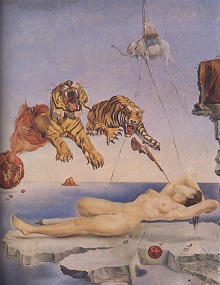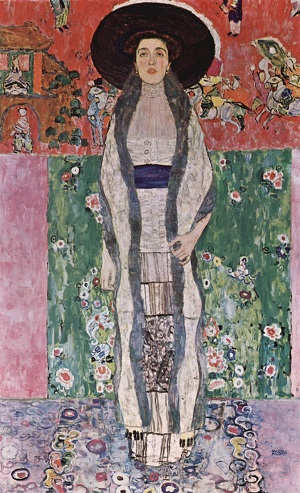art-Klimt.com
Gustav Klimt 1862-1918
The most famous artists of the 19th and 20th century
art-Dali.comSalvador Domingo Felipe Jacinto Dalí i Domènech, 1st Marqués de Dalí de Pubol (May 11, 1904 – January 23, 1989), known as Salvador Dalí, was a prominent Spanish Catalan surrealist painter born in Figueres, Spain. Dalí was a skilled draftsman, best known for the striking and bizarre images in his surrealist work. His painterly skills are often attributed to the influence of Renaissance masters. His best-known work, The Persistence of Memory, was completed in August 1931. Dalí's expansive artistic repertoire included film, sculpture, and photography, in collaboration with a range of artists in a variety of media. Dalí was highly imaginative, and also enjoyed indulging in unusual and grandiose behavior. His eccentric manner and attention-grabbing public actions sometimes drew more attention than his artwork, to the dismay of those who held his work in high esteem, and to the irritation of his critics. |
 The Discovery of America by |
art-Picasso.comThe artistic genius of Pablo Picasso (1881–1973) has impacted the development of modern and contemporary art with unparalleled magnitude. His prolific output includes over 20,000 paintings, prints, drawings, sculptures, ceramics, theater sets and costumes that convey myriad intellectual, political, social, and amorous messages. His creative styles transcend realism and abstraction, Cubism, Neoclassicism, Surrealism, and Expressionism. Born in Malaga, Spain, in 1881, Picasso studied art briefly in Madrid in 1897, then in Barcelona in 1899, where he became closely associated with a group of modernist poets, writers, and artists who gathered at the café Els Quatre Gats (The Four Cats), including the Catalan Carlos Casagemas (1880–1901). |
 Absinthe Drinker |
art-VanGogh.comVan Gogh (van Gogh) Vincent (Vincent Willem) (30.03.1853, Grot-Zundert, Netherlands - 29/07/1890, Auvers-sur-Oise, France), a Dutch painter. The son of a pastor. In 1869-76 he served the commission art-trading company in The Hague, Brussels, London and Paris, in 1876 - as a teacher in England. By studying theology in 1878-79 was a preacher in the Borinage (Belgium), where he learned a difficult life of the miners; protection of their interests resulted in Van Gogh to conflict with church authorities. In the 1880s. Van Gogh refers to art: visits of Arts in Brussels (1880-81) and in Antwerp (1885-86), on the advice of A. Mauve at The Hague. Van Gogh with passion draws disadvantaged people - miners Borinage, and later - peasants, artisans, fishermen, whose life he observed in the Netherlands in 1881-85. At the age of 30 Van Gogh starts to paint and creates an extensive series of paintings and sketches made in the dark, somber colors and steeped in warm sympathy for the common people. |

Still Life Vase with Fifteen Sunflowers |
art-Monet.comOscar-Claude Monet 14 November 1840 – 5 December 1926 was a founder of French Impressionist painting, and the most consistent and prolific practitioner of the movement's philosophy of expressing one's perceptions before nature, especially as applied to plein-air landscape painting.
The term "Impressionism" is derived from the title of his painting Impression, soleil levant (Impression, Sunrise), which was exhibited in 1874 in the first of the independent exhibitions mounted by Monet and his associates as an alternative to the Salon de Paris.
Monet's ambition of documenting the French countryside led him to adopt a method of painting the same scene many times in order to capture the changing of light and the passing of the seasons. From 1883 Monet lived in Giverny, where he purchased a house and property, and began a vast landscaping project which included lily ponds that would become the subjects of his best-known works. In 1899 he began painting the water lilies, first in vertical views with a Japanese bridge as a central feature, and later in the series of large-scale paintings that was to occupy him continuously for the next 20 years of his life |

Women in the garden |
art-Klimt.comGustav Klimt was born 150 years ago, on 14th July 1862, into a lower-middle-class family in the Viennese suburb of Baumgarten as the second of seven children. His childhood and youth coincided with the zenith of the Gründerzeit, the period in nineteenth-century Germany and Austria marked by economic prosperity and large-scale construction. The great Ringstrasse project of monumental building was just entering its final phase. Despite their difficult financial situation, the Klimts enjoyed a harmonious family life, and the siblings remained close throughout their lifetimes. With much sacrifice on the part of the family, the talented young Gustav was sent to Vienna's School of Arts and Crafts (Kunstgewerbeschule), which later became the University of Applied Arts. He soon found himself in the midst of a group of artists who were working on the decoration of the new Ringstrasse buildings. |
<
Portrait of Adele Bloch-Bauer |
art-Matisse.comHenri-Émile-Benoît Matisse 1869 – 1954 was a French artist, known for his use of colour and his fluid and original draughtsmanship. He was a draughtsman, printmaker, and sculptor, but is known primarily as a painter. Matisse is commonly regarded, along with Pablo Picasso and Marcel Duchamp, as one of the three artists who helped to define the revolutionary developments in the plastic arts in the opening decades of the twentieth century, responsible for significant developments in painting and sculpture. Although he was initially labelled a Fauve (wild beast), by the 1920s he was increasingly hailed as an upholder of the classical tradition in French painting. His mastery of the expressive language of colour and drawing, displayed in a body of work spanning over a half-century, won him recognition as a leading figure in modern art. |

Portrait of the Artist's Wife |
art-Gauguin.comGauguin (Gauguin) Eugène Henri Paul (06.07.1848, Paris - 05.08.1903, pos. Atuona, Marquesas Islands), French painter. In his youth he served sailor, from 1871 - a stockbroker in Paris. In the 1870s. alone took up painting. In 1883 threw Exchange and dedicated himself entirely to art, which led to poverty Gauguin, a break with the family, wandering. In 1886 lived in Pont-Aven (Brittany), in 1887 - in Panama and on the island of Martinique, in 1888 he worked for two months (with W. van Gogh) in Arles, in 1889-91 - mainly in Le Pouldu (Brittany) . Early years was due to Impressionism. In the future rejection of bourgeois civilization awaken the interest in folk art, with its naive perception of the world, the art of archaic Greece, the Middle Ages, Ancient East. |

Self portrait with palette 1894 |
art-Degas.comDegas (Degas) Hilaire Germain Edgar (19.07.1834, Paris - 09.27.1917, ibid), French painter, graphic artist and sculptor. In 1855-56 he studied at the Ecole des Beaux-Arts in Paris. In 1854-59 had lived in Italy; studied art of the Italian Quattrocento. Was influenced by JAD Ingres, effort addiction Degas linear basis pictorial form. Began with austere compositions of historical paintings and portraits ("Bellelli Family", about 1858-60, Museum of Impressionism, Paris). Outlined in Degas at the end of the 1860s. the principle of acute and dynamic perception of the environment and everyday life of the person closer together the artist in the 1870s. with Impressionism. Fascinated by the diversity and mobility of urban life, he wrote the contemporary Paris (street theater, cafes, horse racing) in a continuously changing dimensions, recreating the atmosphere of the capitalist city ("Concorde", around 1875, "Absinthe", 1876, Museum of Impressionism). |

The Absinthe Drinker 1876 |
art-Renoir.comAuguste Renoir (25 February 1841 – 3 December 1919), was a French artist who was a leading painter in the development of the Impressionist style. As a celebrator of beauty, and especially feminine sensuality, it has been said that "Renoir is the final representative of a tradition which runs directly from Rubens to Watteau." |

Hills around Moulin Huet Bay, Guernsey |
impressionist-ART.comImpressionism & Post-Impressionism. |
Sunday Afternoon on the Island of La Grande Jatte |
art-Cezanne.comPaul Cézanne (19.01.1839 – 22.10.1906) was a French artist and Post-Impressionist painter whose work laid the foundations of the transition from the 19th-century conception of artistic endeavour to a new and radically different world of art in the 20th century. Cézanne's often repetitive, exploratory brushstrokes are highly characteristic and clearly recognizable. He used planes of colour and small brushstrokes that build up to form complex fields. The paintings convey Cézanne's intense study of his subjects.
Cézanne is said to have formed the bridge between late 19th-century Impressionism and the early 20th century's new line of artistic enquiry, Cubism. Both Matisse and Picasso are said to have remarked that Cézanne "is the father of us all." |

The card players |
art-Turner.comJoseph Mallord William Turner 1775-1851 was an English Romanticist landscape painter. |
 The Fighting Temeraire tugged |